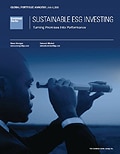Sustainable ESG Investing: Turning Promise into Performance
ESG investing is best thought of as a separate long term investment strategy with an emphasis on the long term competitive advantages of a company that effectively invests in its own structure, its people and its community. At the core of ESG investing is the belief that companies that embrace better business ethics, respect for human dignity and environmental responsibility will over time attract better employees, develop tighter relationships with customers and avoid government censure and thus be able to create more economic value in the long term.
The reason ESG needs to be implemented as a distinct strategy subject to its own review and given its own allocation is that its long term nature of somewhat random timing and the impact of ESG advantages is not amenable to the types of short term performance and attribution technologies that now dominate most of active equity investing. Short term performance metrics inevitably push investment strategies to easily measured and easily tracked metrics with consistent relationships to near term performance, like cost-cutting. Long term public equity investing strategies, like ESG, need to be assessed, like private equity, on long term performance metrics and quality and consistency of process.
Viewed in this light, ESG disclosures and the associated ESG scores become the cornerstone of allowing ESG qualitative assessments by ESG managers, rather than allowing the ESG scores to be the final ESG assessment. This is critical as pure quantitative scoring creates a culture of box checking rather than actual long term commitment to ESG principals. Understanding the difference between box checking and true commitment should be one of the primary skills of an ESG portfolio manager and a basic part of the process review.


